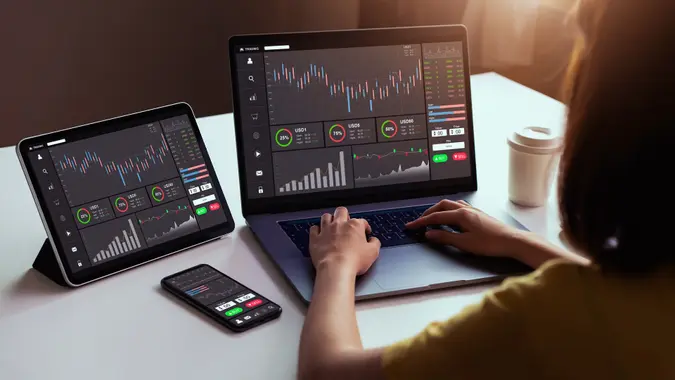How To Day Trade on Robinhood: A Complete Guide

Commitment to Our Readers
GOBankingRates' editorial team is committed to bringing you unbiased reviews and information. We use data-driven methodologies to evaluate financial products and services - our reviews and ratings are not influenced by advertisers. You can read more about our editorial guidelines and our products and services review methodology.

20 Years
Helping You Live Richer

Reviewed
by Experts

Trusted by
Millions of Readers
The term “day trading” refers to buying and selling a stock in a matter of minutes or hours, typically on the same business day. The idea behind day trading is that if you can catch a stock making a move while the market is open, you can snag a quick profit without having to hold a position overnight, when outside news may change its price without you being able to buy or sell it.
Robinhood is a very popular platform for day traders because it charges no commissions on most stock and ETF trades and its app is geared towards the needs of rapid traders. Is day trading a good idea for the average investor, and is Robinhood the right broker to use? Read on to learn more.
What Is Day Trading and How Does It Work on Robinhood?
Definition of Day Trading
According to the Financial Industry Regulatory Authority, or FINRA, day trading occurs when an individual buys or sells — or sells and buys — the same security on the same day “in an attempt to profit from small movements in the price of the security.”
Why Choose Robinhood for Day Trading?
Day traders gravitate towards Robinhood because the platform is very easy to use. You can trade on your mobile phone, and you can access real-time research and analytics. The Robinhood Legend platform provides free access to advanced charts, custom market configurations and dynamically linked layouts, all of which can be helpful for frequent traders.
Perhaps most importantly of all, Robinhood offers zero-commission stock and ETF trades. Since day trading often relies on very small changes in a stock price, commissions and fees can quickly eat into profits. Trading with no commissions is, therefore, an essential part of the process, as even small commissions could eat up the bulk of a day’s profits.
Robinhood Day Trading Rules You Need To Know
One of the many dangers of day trading is violating the pattern day trader rule, which can lead to restrictions on your account. Here’s what you need to know.
Pattern Day Trader Rule
A pattern day trader makes a habit of day trading in a margin account regularly. As this is inherently risky, FINRA, the industry’s regulatory body, aims to restrict it.
According to FINRA, “you’re considered a pattern day trader if you execute four or more “day trades” within five business days–provided that the number of day trades represents more than 6% of your total trades in the margin account for that same five business day period.”
Once you’re labeled a pattern day trader, it’s not something that you can shake off. Generally speaking, firms will consider you a pattern day trader once you’ve been labeled as such, even if you don’t continue making frequent day trades. This is because there’s a “reasonable belief” that your basic investment strategy is to be a day trader, according to FINRA.
The penalty for being a pattern day trader is that you’ll have to pony up additional capital to protect against losses in your account. Specifically, on any day that you trade, you must keep at least $25,000 in cash in your account.
Note that these pattern day trading restrictions are not unique to Robinhood. They are FINRA requirements, and every brokerage enforces them.
Avoiding Violations
The easiest way to avoid a violation is to execute three or fewer day trades during any five-trading-day period. Robinhood does offer a Day Trade Counter in the app to help keep you from going over the limit of day trades. Plus, you can set up your app to alert you when you’re about to place your fourth day trade of the day.
How To Avoid the Pattern Day Trader Rule
If you’re inherently a day trader by nature, you can trade in an unrestricted manner if you use a cash account instead of a margin account.
Setting Up Your Robinhood Account for Day Trading
Open a Robinhood Account
You can’t day trade on Robinhood without an account. However, process is easy and can be accomplished online rapidly. You can open either a standard account, which is free, or a Robinhood Gold account, which costs $5 per month and provides added features, such as a 4% APY on cash balances, a 3% IRA match on deposits and 3% cash back on Robinhood Gold card purchases.
While the online process to open an account is fast, Robinhood may ask to verify your documentation by uploading pictures of your valid ID, bank statement, or both. The verification process may take a few days.
Fund Your Account
You can open a Robinhood account with as little as $1. However, if you plan on pattern day trading in your account, you may have to deposit $25,000, so be sure you have that much available.
Activate Margin for More Buying Power
You can avoid the pattern day trader label and $25,000 balance requirement if you use a cash account. However, if you open a margin account, you can leverage your trades and have access to additional buying power.
With a margin account, you can deposit $10,000, for example, and use it to buy $15,000 worth of stocks. When you are on margin, you borrow the additional money from the brokerage firm and pay interest on the amount you borrow. This brings an additional cost to your trading. However, your returns are leveraged, meaning you can amplify the amount you earn.
Imagine, for example, that you buy $15,000 of stocks but only put up $10,000 of your own money. If the stocks go up by 10%, they’ll be worth $16,500. Since you only put up $10,000, though, you’ll end up with a gain of 15%, not 10%.
Of course, leverage works both ways. If your stocks go down, you’ll lose money more rapidly if you’re on margin as well.
How To Execute a Day Trade on Robinhood
Finding Stocks To Day Trade
One of the reasons Robinhood is popular with day traders is that it has extensive charts, screening tools and watchlists that are geared towards active traders. You can use this information to find stocks that may be appropriate candidates for day trading.
Generally, day traders will gravitate to stocks with high volatility, as they offer the best chance for capturing big price movements in a short period. High volatility goes hand-in-hand with high risk, but it also offers the potential for high return — something most day traders seek.
Placing a Day Trade Order
Placing a day trader order on Robinhood is simple.
- On the app, select the stock you want
- Hit the “trade” button
- Select buy or sell
- Choose if you want a market or a limit order. A market order will be executed immediately, while a limit order will only execute at your desired price or better.
The steps are similar if you use the Robinhood web portal.
To maximize your trade’s profitability, you’ll need to understand the trading tendencies of the stock, something that Robinhood’s features can help you with. The idea is to buy when a stock is moving up and sell when it reverses its trend. This is a skill that even professional money managers struggle with, so it’s best to start small with day trading and only invest amounts that you can afford to lose.
Using Robinhood’s Instant Features
Robinhood Instant Deposits allow you to access your deposit and trade instantly, up to $1,000. If you have a Robinhood Gold account, that limit may be raised.
With a margin account, you can also get Instant Settlement, allowing you to trade with funds from sales that have not yet settled.
Day Trading Strategies on Robinhood
Scalping
Scalping is an aggressive form of day trading in which traders rapidly take very small profits from minor price fluctuations in a stock. A scalper might buy a stock at $50 and sell it at $50.25, for example, repeating the process over and over and accumulating a large number of small gains.
Momentum Trading
Momentum trading isn’t technically “day” trading, as it usually involves buying and holding stocks that are in an uptrend over several days or weeks. Momentum trading can be used when the overall market trend is up or when a stock has multiple tailwinds that are pushing it higher, such as a strong earnings report, analyst upgrades or favorable news. Generally, momentum traders jump in when an upward move in price is made in conjunction with increased volume.
Swing Trading
Swing trading is also a type of short-term trading that extends for periods longer than a day. However, it differs from momentum trading in that swing traders generally use technical price points as the buy and sell levels for their trades. For example, if a stock has been trading between $50 and $60 with regularity, a swing trader might pick up shares as the stock approaches $50 and unload them as it nears $60.
FAQs on How To Day Trade on Robinhood
Here are the answers to some of the most frequently asked questions about day trading on Robinhood.- What is the minimum balance required for day trading on Robinhood?
- Although you can open a Robinhood account for only $1, if you want to day trade on margin, you'll have to deposit at least $25,000. However, if you day trade in a cash account, there is no such restriction.
- Can I use margin for day trading on Robinhood?
- Yes, you can use margin to day trade on Robinhood. However, you'll likely need to adhere to the $25,000 minimum capital requirement that's enforced by FINRA.
- What happens if I violate the pattern day trader rule?
- If you violate the PDT rule, your account will be limited to closing positions only, meaning you can't initiate any new purchases. This restriction can be lifted if you raise your cash balance in your margin account to $25,000.
- How do I find good stocks for day trading on Robinhood?
- Day trading is part art and part science. You can use the extensive research tools on Robinhood to find stocks that exhibit volatility patterns that make them conducive to day trading. Be sure that you understand all the risks, however, as most day traders end up losing money.
- Are there fees for day trading on Robinhood?
- There are no commissions to buy and sell stocks and ETFs on Robinhood. Day trading in a margin account requires you to maintain a certain amount of funds, but there are no associated fees.
Editorial Note: This content is not provided by any entity covered in this article. Any opinions, analyses, reviews, ratings or recommendations expressed in this article are those of the author alone and have not been reviewed, approved or otherwise endorsed by any entity named in this article.
Our in-house research team and on-site financial experts work together to create content that’s accurate, impartial, and up to date. We fact-check every single statistic, quote and fact using trusted primary resources to make sure the information we provide is correct. You can learn more about GOBankingRates’ processes and standards in our editorial policy.
- FINRA. "Day Trading."
- Robinhood. "Pattern Day Trade Protection."
 Written by
Written by  Edited by
Edited by 
























